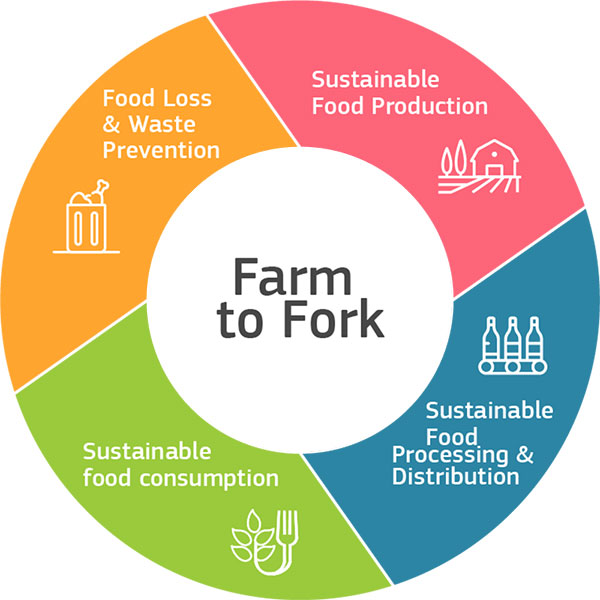Published in June 2020 as part of the European Green Deal – the most environmentally ambitious legislative proposal of the new EU Commission – the Farm to Fork Strategy aims to increase the sustainability of the European food system in several dimensions as well as reduce its impact on third countries. So far, the ambitious nature of the strategy as well as its holistic approach has been met with a largely positive response from the public. The strategy affects many sectors, from agriculture to food labeling, and needs to detailed consideration to understand why it is critical to the future of European food systems.
The Farm to Fork (F2F) Strategy involves a comprehensive 10-year plan that aims to drive the transition to a fair, healthy and environmentally friendly food system in Europe. It is the first serious attempt by the EU to design a food policy that proposes actions and targets for each stage of the food value chain, from production to distribution to consumption. Each of the EU member states is required to implement the strategy at the national level.
The Farm to Fork Strategy aligns with the Sustainable Development Goals (SDGs) propagated by the UN and also aims to raise standards globally through international cooperation and trade policies.
What are the main aims of the Farm to Fork strategy?
- Ensuring sustainable food production
- Ensuring food security
- Promoting sustainable practices in food processing, wholesale, retail, hospitality and catering
- Promoting sustainable food consumption and the transition to healthy, sustainable diets
- Reducing food waste
- Combating food fraud along the food value chain
The EU has set a number of key targets to reach by 2030 that it considers essential to achieving the Farm to Fork goals, some of which also reflect the EU’s Biodiversity Strategy:
- Achieve a 50% reduction in the use and risk of chemical pesticides and more hazardous pesticides
- Reduce nutrient losses by at least 50%, while ensuring that there is no degradation of soil fertility. At the same time, achieve a 20% reduction in the use of fertilizers
- Achieve a 50% reduction in the total sales of antimicrobials for livestock and aquaculture in the EU
Increase share of agricultural land used for organic farming to 25%.
How will the goals of the Farm to Fork strategy be achieved?
Ambitious goals are not enough if they are not accompanied by concrete support measures to achieve them. The F2F strategy is not absolutely mandatory for all member states of the EU. Knowledge, education, and a shift in financial support will be key to enabling all actors in the food system to farm and operate more sustainably by developing alternatives to chemical pesticides, complying with labeling systems, etc. The strategy proposes several reforms to existing policies to achieve the goals: including a review of the Animal Welfare Regulation and the Sustainable Use of Pesticides Directive. In addition, the new goals and targets must also be reflected in the Common Agricultural Policy, through ambitious national strategic plans currently being developed by individual countries. By 2023, the Commission will present legislative proposals for a sustainable food system framework to help align national policies and ensure the coherence of all food-related policies.

Copyright EU. Original location
How will the strategy affect European agriculture and the food we buy and eat?
The Farm to Fork strategy aims to help European agriculture move towards more sustainable practices in the coming years by reducing the use of external inputs, such as chemical pesticides and fertilizers, and working more in harmony with the environment in the production of our food. Transparency in the food chain will increase for consumers by providing more information about the origin of food and nutritional aspects through better labeling. The strategy proposes a number of measures to make it easier for consumers to access healthy and sustainable food; stricter standards in public procurement will result in public institutions such as schools and hospitals having to offer more sustainable food. Finally, businesses will need to reduce their environmental footprint and reformulate their food products to satisfy stricter guidelines for healthy and sustainable food.
How will this strategy support the European agricultural and fishing industries?
The Farm to Fork strategy offers a system of rewards for those working in the farming and fishing as well as those along the food chain who have already made the transition to sustainable practices and who can support others in adapting. The Common Agricultural Policy (CAP) and the Common Fisheries Policy (CFP) will remain key instruments that will support the farming and fishing communities during their transition to sustainable food systems. The Farm to Fork strategy is vague about the actual steps the agricultural and fishing sectors must take to receive support. It is also unclear what tools will be used to facilitate the transition.
Can the strategy be changed and improved?
The strategy is a long-term plan initially covering the next 10 years that is based on the implementation and revision of a broad range of specific policies. While its core commitments are likely to remain unchanged, close monitoring of the implementation of the “Farm to Fork” strategy and feedback on the various policy reforms will be essential.
Find out more about the “Farm to Fork” strategy:
We have put together an number of resources and articles to help you dig in to the strategy.
- EU website on Farm to Fork
- European Policy Centre critique of the Farm to Fork Strategy: The Farm to Fork strategy and the inconvenient truth
- Slowfood.com examine Farm to Fork: The Commission Takes a Promising Step Towards a Sustainable Europe
- STADTLANDBIO: Dr. Claudio Serafini takes part in a podium discussion entitled Farm to Fork and the EU strategy – What opportunities do they offer for municipalities and regions? at STADTLANDBIO 2021.

